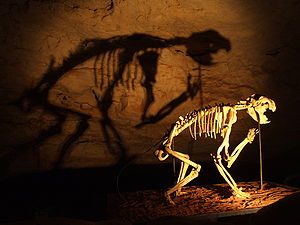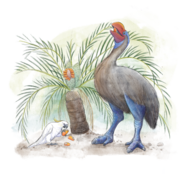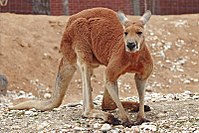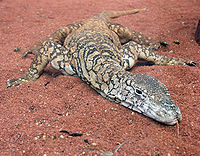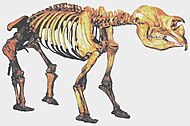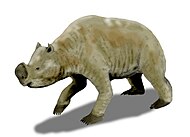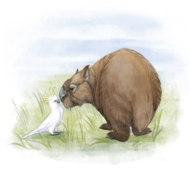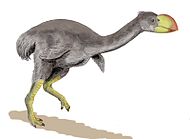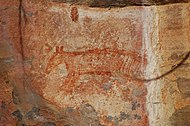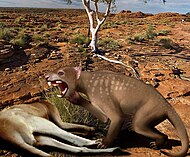
Diprotodon is an extinct genus of marsupial from the Pleistocene of Australia containing one species, D. optatum. The earliest finds date to 1.77 million to 780,000 years ago but most specimens are dated to after 110,000 years ago. Its remains were first unearthed in 1830 in Wellington Caves, New South Wales, and contemporaneous paleontologists guessed they belonged to rhinos, elephants, hippos or dugongs. Diprotodon was formally described by English naturalist Richard Owen in 1838, and was the first named Australian fossil mammal, and led Owen to become the foremost authority of his time on other marsupials and Australian megafauna, which were enigmatic to European science.

In zoology, megafauna are large animals. The most common thresholds to be a megafauna are weighing over 45 kg (99 lb) or weighing over 1,000 kg (2,200 lb). The first occurrence of the term was in 1876. After the Cretaceous–Paleogene extinction event wiped out all non-avian dinosaurs, mammals and other vertebrates experienced an expansion in size. Millions of years of evolution led to gigantism on every major land mass. During the Quaternary extinction event, many species of megafauna went extinct as part of a slowly progressing extinction wave that affected ecosystems worldwide.

Genyornis newtoni, also known as the Newton's mihirung, Newton's thunder bird or mihirung paringmal, is an extinct species of large, flightless bird that lived in Australia during the Pleistocene Epoch until around 50,000 years ago. Over two metres in height, they were likely herbivorous. Many other species of Australian megafauna became extinct in Australia around that time, coinciding with the arrival of humans. It is the last known member of the extinct flightless bird family Dromornithidae which had been part of the fauna of the Australian continent for over 30 million years. They are not closely related to ratites such as emus, and their closest living relatives are thought to be fowl.

Megalania is an extinct species of giant monitor lizard, part of the megafaunal assemblage that inhabited Australia during the Pleistocene. It is the largest terrestrial lizard known to have existed, reaching an estimated length of 3.5 to 7 metres, and weighing between 97–1,940 kg (214–4,277 lb), but the fragmentary nature of known remains make estimates highly uncertain.

Thylacoleo is an extinct genus of carnivorous marsupials that lived in Australia from the late Pliocene to the Late Pleistocene, often known as marsupial lions. They were the largest and last members of the family Thylacoleonidae, occupying the position of apex predator within Australian ecosystems. The largest and last species, Thylacoleo carnifex approached the weight of a lioness. The estimated average weight for the species ranges from 101 to 130 kg.
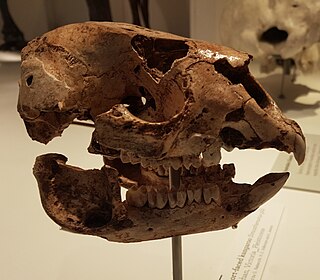
Procoptodon is an extinct genus of giant short-faced (sthenurine) kangaroos that lived in Australia during the Pleistocene Epoch. P. goliah, the largest known kangaroo species that ever existed, stood at about 2 m (6.6 ft). They weighed about 200–240 kg (440–530 lb). Other members of the genus were smaller, however; Procoptodon gilli was the smallest of all of the sthenurine kangaroos, standing approximately 1 m tall.

Dromornithidae, known as mihirungs and informally as thunder birds or demon ducks, were a clade of large, flightless Australian birds of the Oligocene through Pleistocene Epochs. All are now extinct. They were long classified in Struthioniformes, but are now usually classified as galloanseres. Dromornithids were part of the Australian megafauna. One species, Dromornis stirtoni, was 3 m tall. Only a single species, Genyornis newtoni survived into the Late Pleistocene. They are thought to have been herbivorous.
Cuddie Springs is a notable archaeological and paleontological site in the semi-arid zone of central northern New South Wales, Australia, near Carinda in Walgett Shire. Cuddie Springs is an open site, with the fossil deposits preserved in a claypan on the floor of an ancient ephemeral lake. The claypan fills with water after local rainstorms and often takes months to dry, a fact which facilitated the survival of fossils over a long period of time.
The giant koala is an extinct arboreal marsupial which existed in Australia during the Pleistocene epoch. Phascolarctos stirtoni was about one-third larger than the contemporary koala, P. cinereus, and has an estimated weight of 13 kg (29 lb), which is the same weight as a large contemporary male koala.

Sthenurus is an extinct genus of kangaroos. With a length around 3 m (10 ft), some species were twice as large as modern extant species. Sthenurus was related to the better-known Procoptodon. The subfamily Sthenurinae is believed to have separated from its sister taxon, the Macropodinae, halfway through the Miocene, and then its population grew during the Pliocene.
The natural history of Australia has been shaped by the geological evolution of the Australian continent from Gondwana and the changes in global climate over geological time. The building of the Australian continent and its association with other land masses, as well as climate changes over geological time, have created the unique flora and fauna present in Australia today.

Protemnodon is an extinct genus of megafaunal macropodids that existed in Australia, Tasmania, and New Guinea in the Pliocene and Pleistocene. Members of this genus are also called giant kangaroos.

Simosthenurus, also referred to as the short-faced kangaroo, is an extinct genus of megafaunal macropods that existed in Australia, specifically Tasmania, during the Pleistocene. Analysis of Simosthenurus fossils has contributed to the finding that there are three lineages of macropods: Sthenurinae, Macropodinae, and Lagostrophinae. The genus Simosthenurus was among the sthenurines.
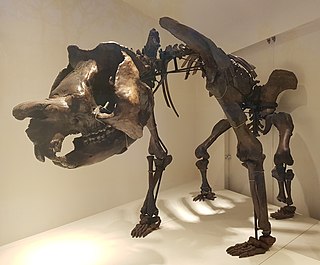
Zygomaturus is an extinct genus of giant marsupial belonging to the family Diprotodontidae which inhabited Australia from the Late Miocene to Late Pleistocene.

The Late Pleistocene to the beginning of the Holocene saw numerous extinctions of predominantly megafaunal animal species, which resulted in a collapse in faunal density and diversity across the globe. The extinctions during the Late Pleistocene are differentiated from previous extinctions by the widespread absence of ecological succession to replace these extinct megafaunal species, and the regime shift of previously established faunal relationships and habitats as a consequence. The timing and severity of the extinctions varied by region and are thought to have been driven by varying combinations of human and climatic factors. Human impact on megafauna populations is thought to have been driven by hunting ("overkill"), as well as possibly environmental alteration. The relative importance of human vs climatic factors in the extinctions has been the subject of long-running controversy.

Diprotodontidae is an extinct family of large herbivorous marsupials, endemic to Australia and New Guinea during the Oligocene through Pleistocene periods from 28.4 million to 40,000 years ago.

Murrayglossus is an extinct echidna from the Pleistocene of Western Australia. It contains a single species, Murrayglossus hacketti, also called Hackett's giant echidna. Though only from a few bones, researchers suggest that Murrayglossus was the largest monotreme to have ever lived, measuring around 1 metre (3.3 ft) long and weighing around 20–30 kilograms (44–66 lb). Historically treated as a species of long-beaked echidnas, it was separated into its own genus Murrayglossus in 2022. The generic name combines the last name of paleontologist Peter Murray and glossus, the Greek word for "tongue".

Evolutionary anachronism, also known as "ecological anachronism", is a term initially referring to attributes of native plant species that seemed best explained as having been favorably selected in the past due to their coevolution with plant-eating megafauna that are now extinct. Diminished effectiveness and distance of seed dispersal by fruit-eating mammals inhabiting the same ecosystems today suggest maladaptation. Maladaptation of such fruiting plants will intensify as ongoing climate change shifts the physical and ecological conditions within their current geographic range.

Progura is an extinct genus of megapode that was native to Australia. It was described from Plio-Pleistocene deposits at the Darling Downs and Chinchilla in southeastern Queensland by Charles De Vis.
Warratyi is the site of a rock shelter in the Flinders Ranges in South Australia. Located around 550 kilometres (340 mi) north of Adelaide and about 200 kilometres (120 mi) inland, it has been identified as the oldest known site of human habitation in inland Australia. Newspapers reported that this rock shelter was discovered by chance in 2011 by a local resident who stumbled upon it while looking for somewhere to go to the toilet. Researchers found thousands of artefacts and bone fragments, which enabled them to date the shelter's occupation to a number of periods between 49,000 and 10,000 years ago. The finds include the earliest evidence in Australia of the development of bone and stone-axe technology, the use of ochre, and interaction with megafauna such as Diprotodon.
